Theoretical Study on the Ultrafast Selective Excitation of Surface-Enhanced Coherent Anti-Stokes Raman Scattering Based on Fano Resonance of Disk-Ring Nanostructures by Shaped Femtosecond Laser Pulses
Abstract
:1. Introduction
2. Ultrafast Coherent Control and Selective Excitation of CARS
2.1. Theory of the Coherent Control of CARS
2.2. Selective Excitation of CARS Peaks
3. SECARS Based on Fano Resonance in a Disk-Ring Nanostructure
4. Ultrafast Selective Excitation of SECARS
4.1. Ultrafast Dynamics of the Shaping Laser Pulses on the Disk-Ring Structure
4.2. SECARS Based on Fano Resonance in the Disk-Ring Structure
4.3. Selective Excitation of SECARS
4.3.1. Spectra of the Response Pulses
4.3.2. Phase of the Response Pulses
4.3.3. Selectivity of SECARS and the Fidelity of Spectra
5. Conclusions
Author Contributions
Funding
Data Availability Statement
Conflicts of Interest
Appendix A
Appendix A.1. Optimization of the Selective Excitation of CARS

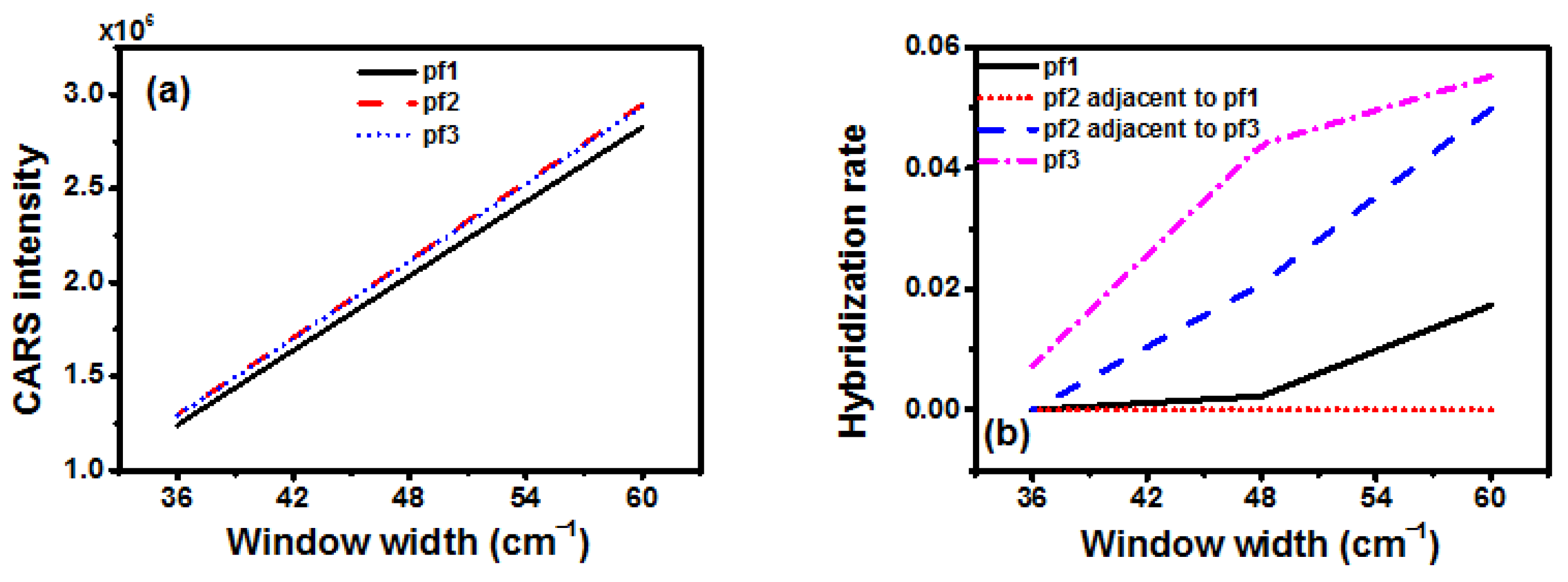
Appendix A.2. Spectra, Phase, and Time Distributions of the Three Optimized Anti-Stokes Pulses
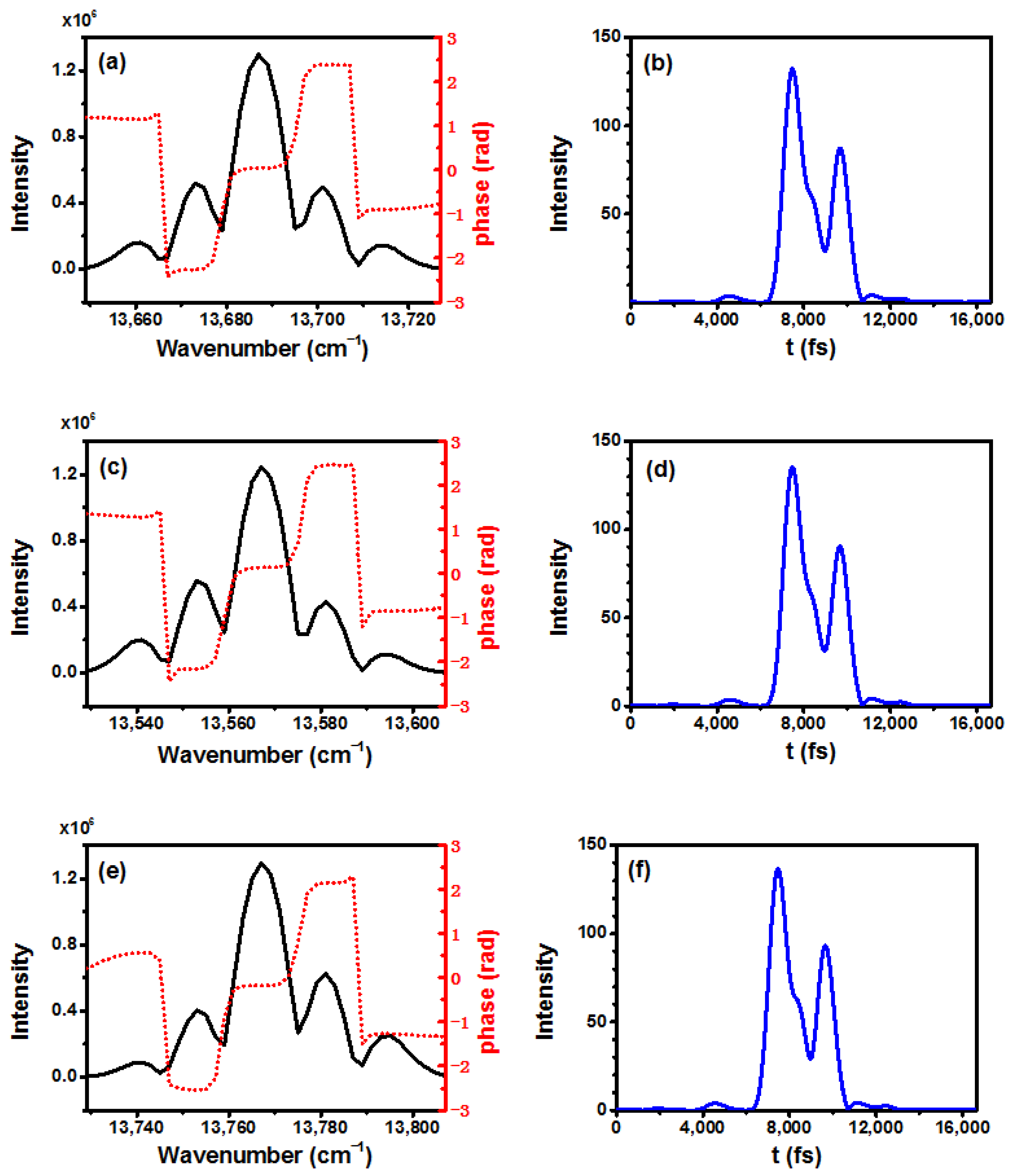
Appendix B
The Time Distribution of the Real Part of the Electric Field of the Stokes, Probe, and Anti-Stokes Pulse
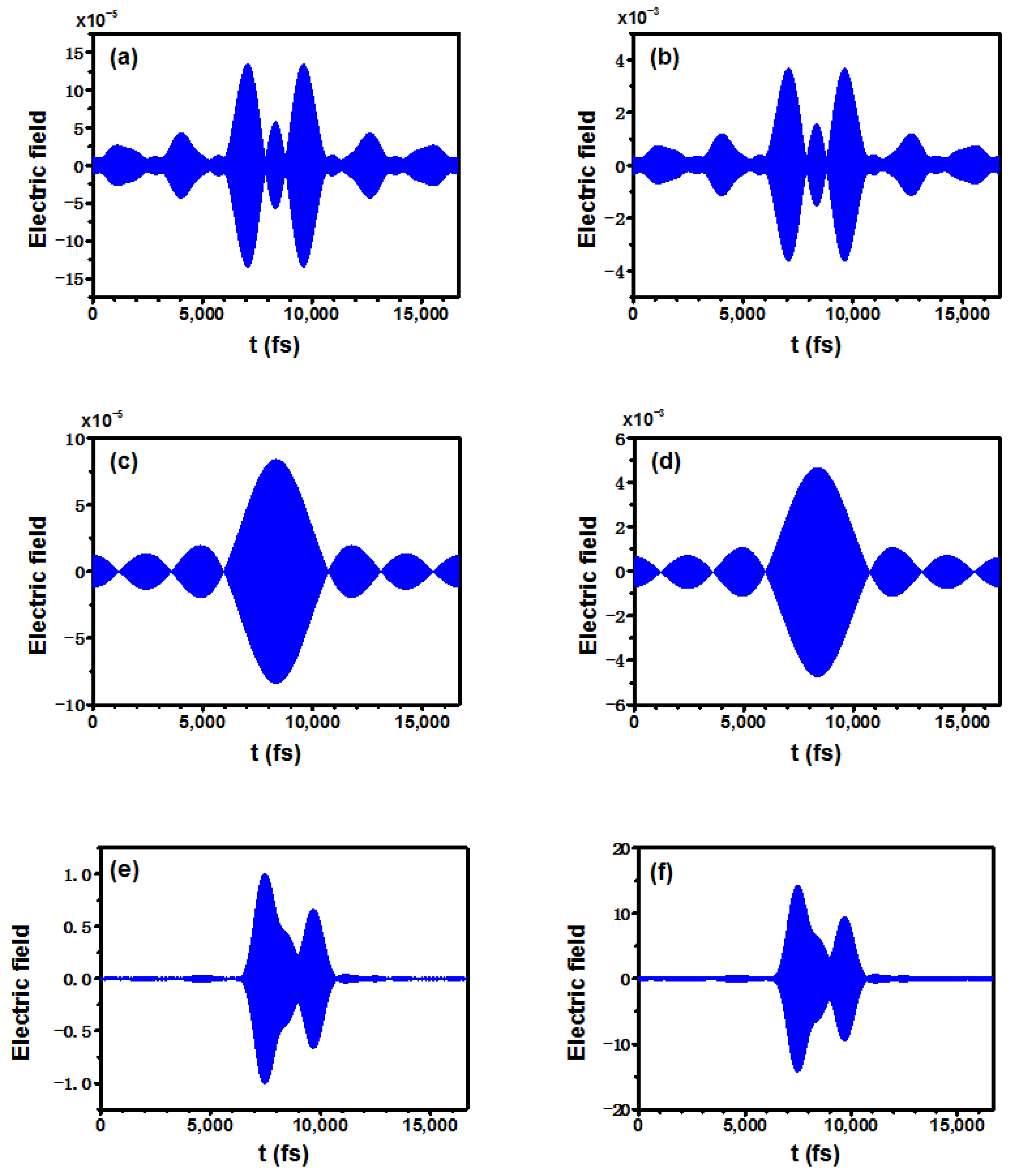
Appendix C
SECARS for the Step Position of the Stokes Light at 12,267 cm−1 and 12,187 cm−1

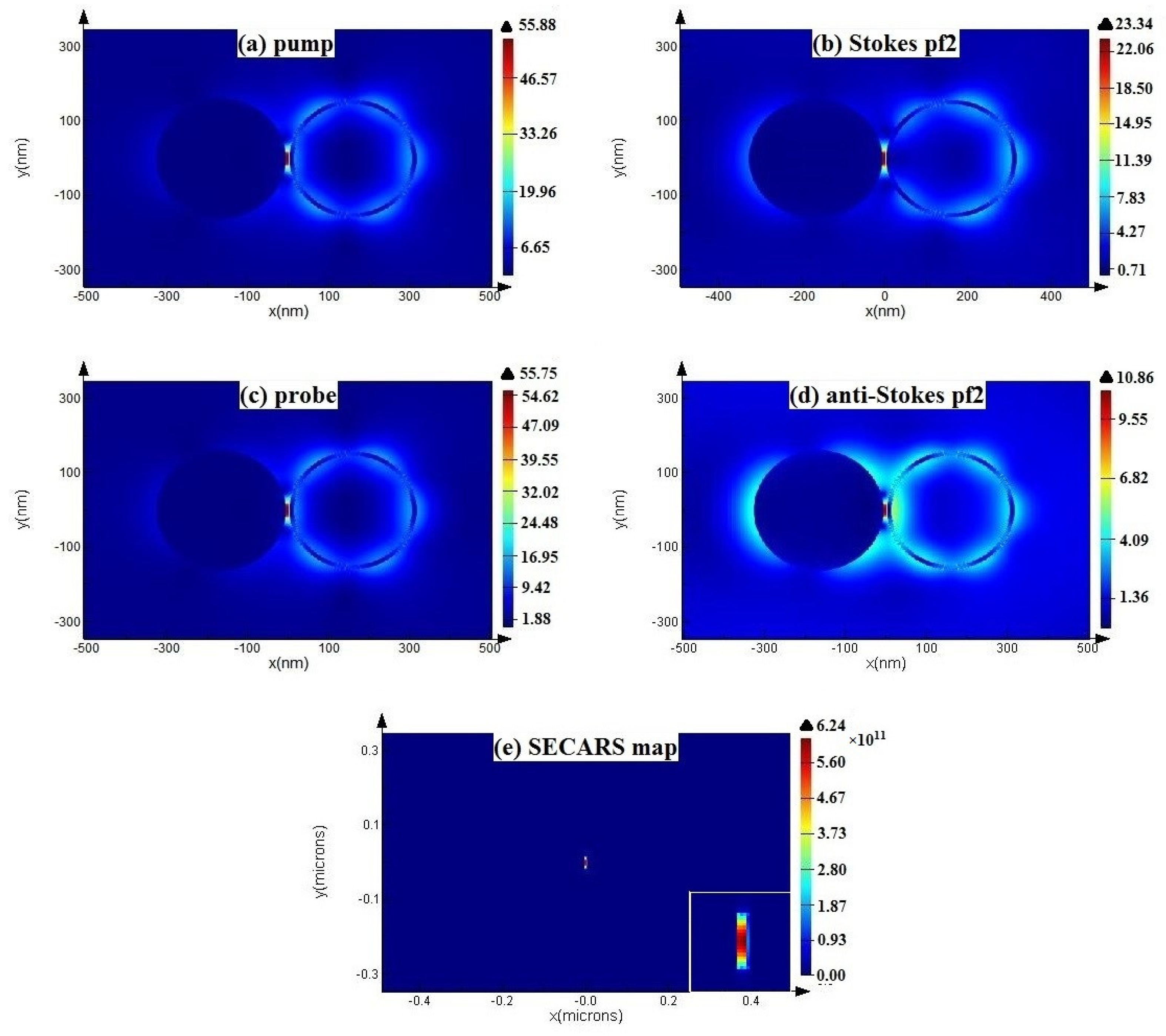
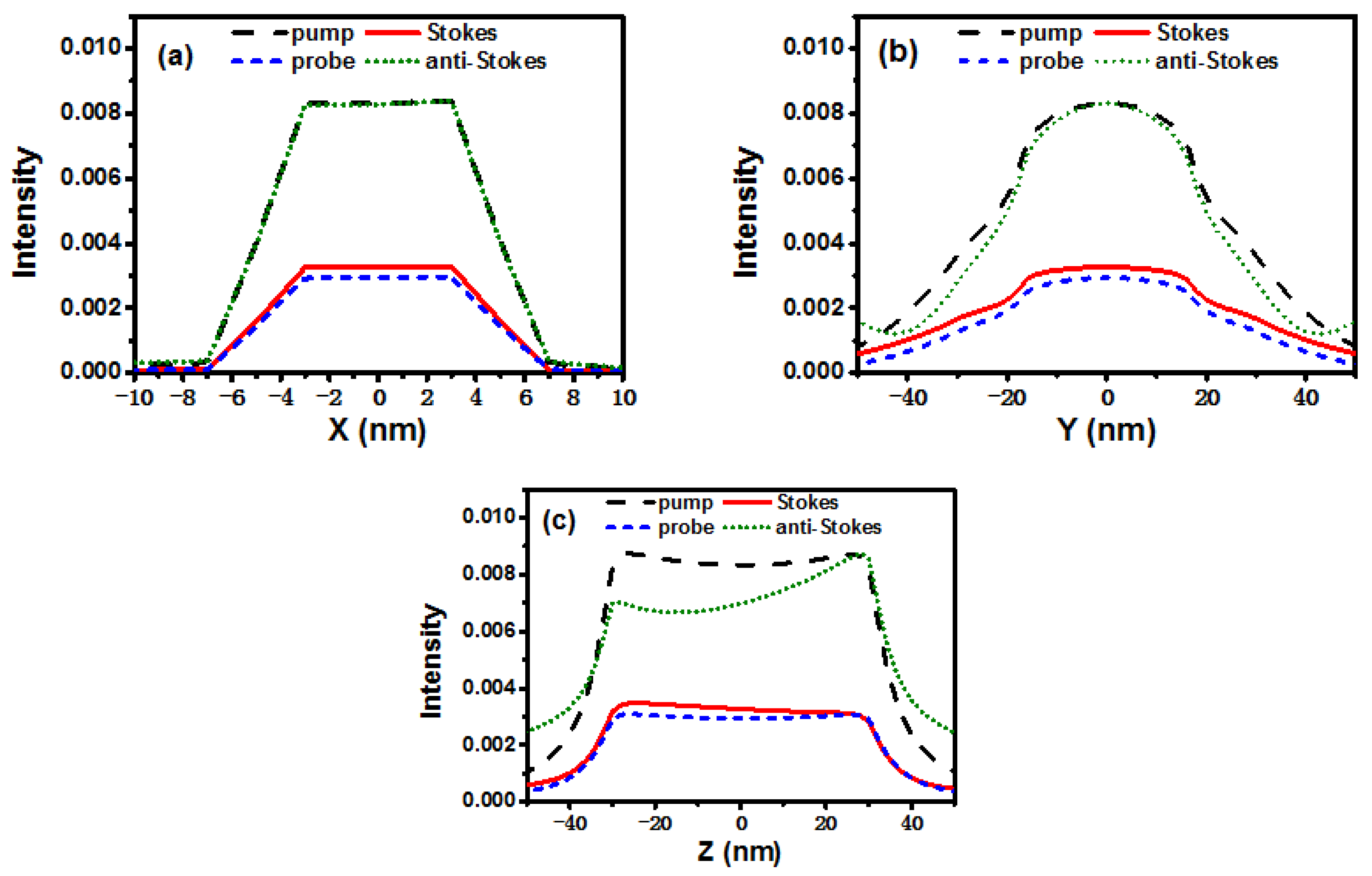

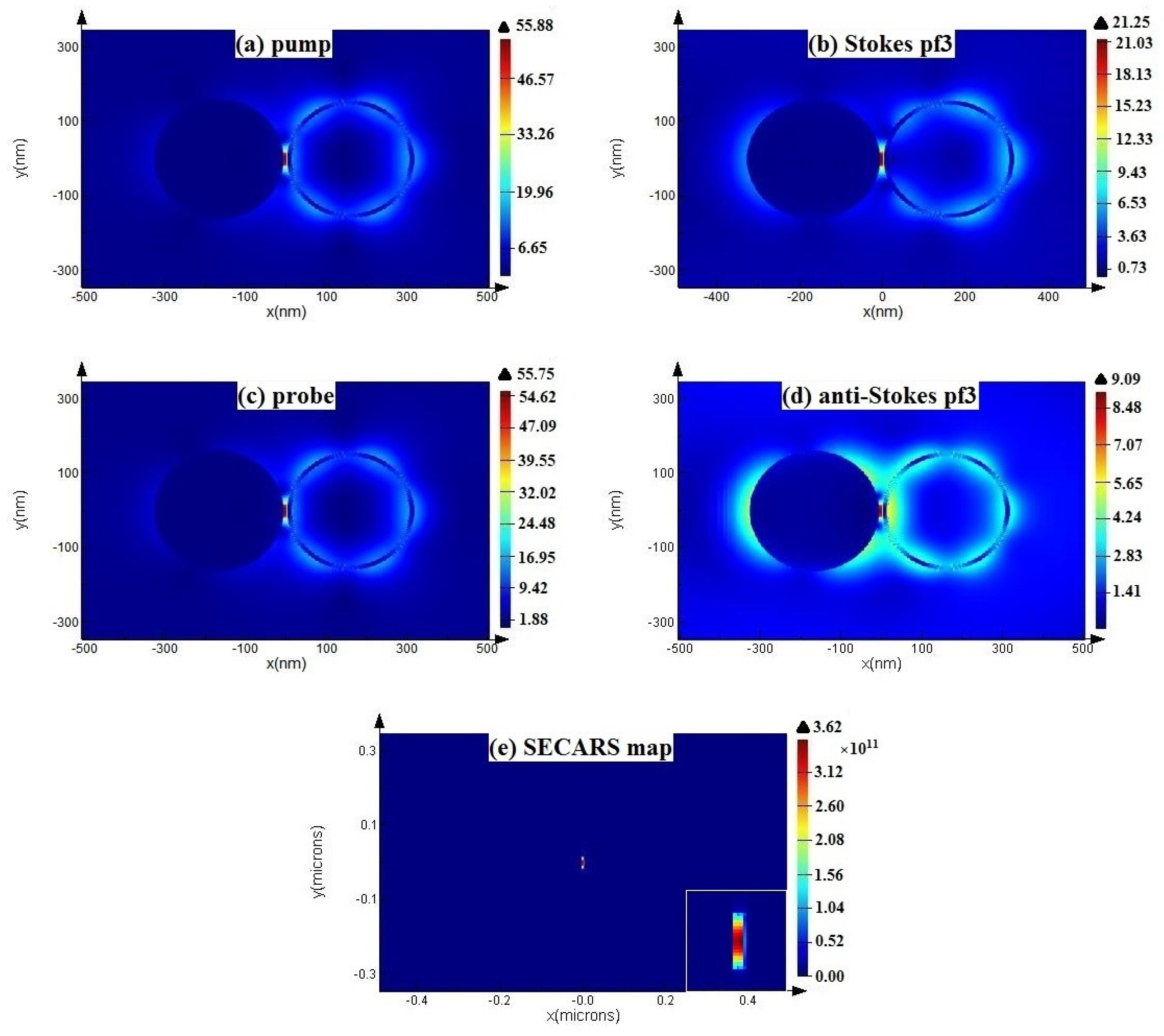
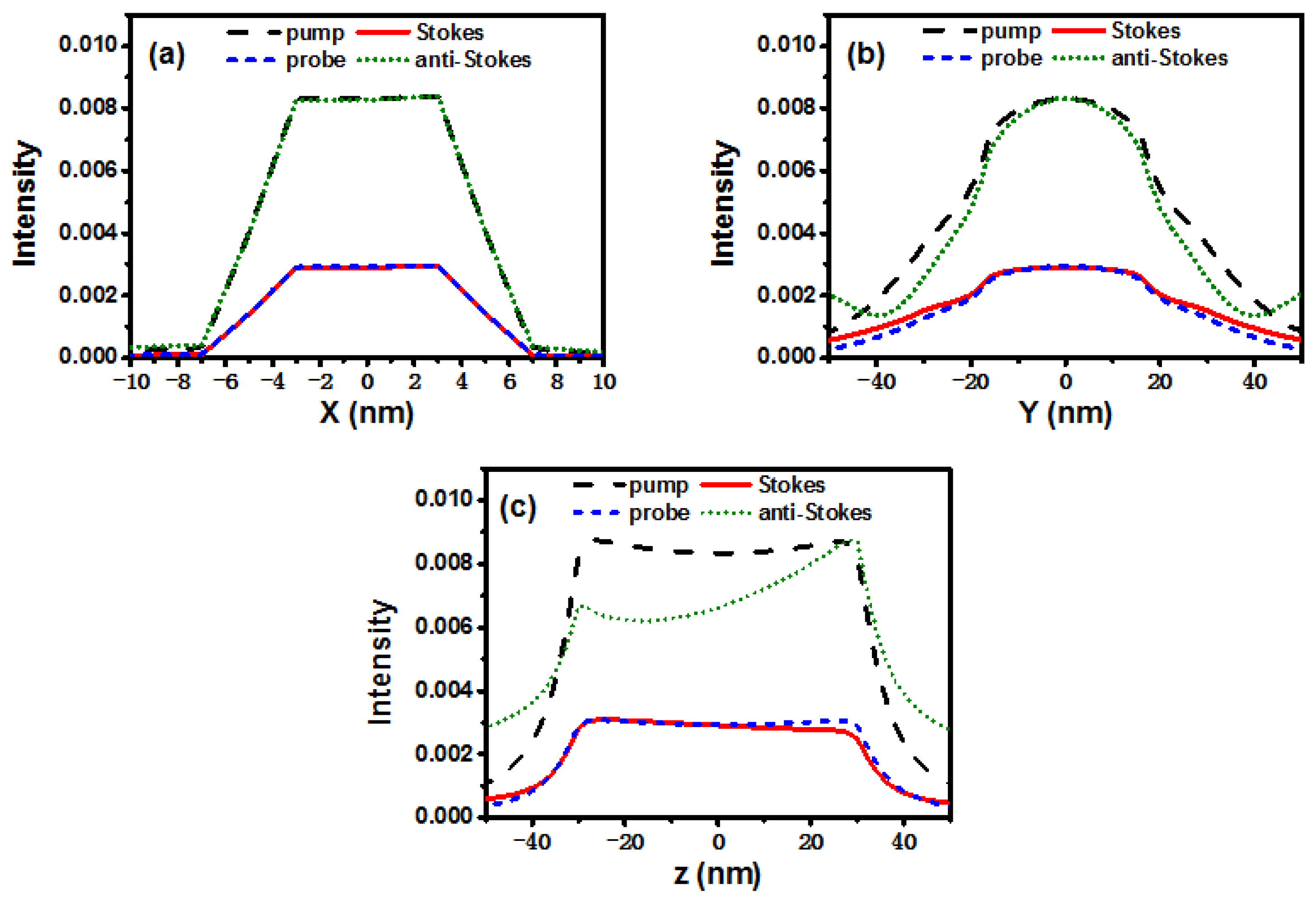
References
- Voronine, D.V.; Zhang, Z.; Sokolov, A.V.; Scully, M.O. Surface-enhanced FAST CARS: En route to quantum nano-biophotonics. Nanophotonics 2018, 7, 523–548. [Google Scholar] [CrossRef]
- Zhang, Y.; Zhen, Y.R.; Neumann, O.; Day, J.K.; Nordlander, P.; Halas, N.J. Coherent anti-Stokes Raman scattering with single-molecule sensitivity using a plasmonic Fano resonance. Nat. Commun. 2014, 5, 4424. [Google Scholar] [CrossRef] [PubMed]
- Zumbusch, A.; Holtom, G.R.; Xie, X.S. Three-dimensional vibrational imaging by coherent anti-Stokes Raman scattering. Phys. Rev. Lett. 1999, 82, 4142–4145. [Google Scholar] [CrossRef] [Green Version]
- Karuna, A.; Masia, F.; Wiltshire, M.; Errington, R.; Borri, P.; Langbein, W. Label-free volumetric quantitative imaging of the human somatic cell division by hyperspectral coherent anti-Stokes Raman scattering. Anal. Chem. 2019, 91, 2813–2821. [Google Scholar] [CrossRef] [Green Version]
- Rahman, K.A.; Braun, E.L.; Slipchenko, M.N.; Roy, S.; Meyer, T.R. Flexible chirp-free probe pulse amplification for kHz fs/ps rotational CARS. Opt. Lett. 2020, 45, 503–506. [Google Scholar] [CrossRef]
- Ren, L.; Hurwitz, I.; Raanan, D.; Oulevey, P.; Oron, D.; Silberberg, Y. Terahertz coherent anti-Stokes Raman scattering microscopy. Optica 2019, 6, 52–55. [Google Scholar] [CrossRef]
- Wu, T.; Chen, K.; Wei, H.; Li, Y. Repetition frequency modulated fiber laser for coherent anti-Stokes Raman scattering. Opt. Lett. 2020, 45, 407–410. [Google Scholar] [CrossRef]
- Assion, A.; Baumert, T.; Bergt, M.; Brixner, T.; Kiefer, B.; Seyfried, V.; Strehle, M.; Gerber, G. Control of chemical reactions by feedback-optimized phase-shaped femtosecond laser pulses. Science 1998, 282, 919–922. [Google Scholar] [CrossRef]
- Aljakouch, K.; Hilal, Z.; Daho, I.; Schuler, M.; Krauß, S.D.; Yosef, H.K.; Dierks, J.; Mosig, A.; Gerwert, K.; El-Mashtoly, S.F. Fast and noninvasive diagnosis of cervical cancer by coherent anti-Stokes Raman scattering. Anal. Chem. 2019, 91, 13900–13906. [Google Scholar] [CrossRef]
- Ran, Y.; Junghanns, M.; Boden, A.; Nolte, S.; Tünnermann, A.; Ackermann, R. Temperature and gas concentration measurements with vibrational ultra-broadband two-beam femtosecond/picosecond coherent anti-Stokes Raman scattering and spontaneous Raman scattering. J. Raman Spectrosc. 2019, 50, 1268–1275. [Google Scholar] [CrossRef]
- Zhang, S.; Zhang, H.; Wang, Z.; Sun, Z. Selective excitation and suppression of coherent anti-Stokes Raman scattering by shaping femtosecond pulses. Chin. Phys. B 2010, 19, 043201. [Google Scholar]
- Oron, D.; Dudovich, N.; Yelin, D.; Silberberg, Y. Quantum control of coherent anti-Stokes Raman processes. Phys. Rev. A 2002, 65, 043408. [Google Scholar] [CrossRef]
- Wipfler, A.; Buckup, T.; Motzkus, M. Fast single-beam-CARS imaging scheme based on in silico optimization of excitation phases. J. Raman Spectrosc. 2015, 46, 679–682. [Google Scholar] [CrossRef]
- Knutsen, K.P.; Johnson, J.C.; Miller, A.E.; Petersen, P.B.; Saykally, R.J. High spectral resolution multiplex CARS spectroscopy using chirped pulses. Chem. Phys. Lett. 2004, 387, 436–441. [Google Scholar] [CrossRef]
- Yan, Z.; Liu, Z.; Xia, M.; Efimova, A.; Xie, Y. Broadband surface-enhanced coherent anti-Stokes Raman spectroscopy with high spectral resolution. J. Raman Spectrosc. 2017, 48, 935–942. [Google Scholar] [CrossRef]
- Zhang, S.; Zhang, L.; Zhang, X.; Ding, L.; Chen, G.; Sun, Z.; Wang, Z. Selective excitation of CARS by adaptive pulse shaping based on genetic algorithm. Chem. Phys. Lett. 2007, 433, 416–421. [Google Scholar] [CrossRef]
- Konradi, J.; Singh, A.K.; Scaria, A.V.; Materny, A. Selective spectral filtering of molecular modes of β-carotene in solution using optimal control in four-wave-mixing spectroscopy. J. Raman Spectrosc. 2006, 37, 697–704. [Google Scholar] [CrossRef]
- Oron, D.; Dudovich, N.; Yelin, D.; Silberberg, Y. Narrow-band coherent anti-Stokes Raman signals from broad-band pulses. Phys. Rev. Lett. 2002, 88, 063004. [Google Scholar] [CrossRef]
- Zhang, S.; Zhang, H.; Jia, T.; Wang, Z.; Sun, Z. Selective excitation of femtosecond coherent anti-Stokes Raman scattering in the mixture by phase-modulated pump and probe pulses. J. Chem. Phys. 2010, 132, 044505. [Google Scholar] [CrossRef] [Green Version]
- Kolesnichenko, P.V.; Tollerud, J.O.; Davis, J.A. Background-free time-resolved coherent Raman spectroscopy (CSRS and CARS): Heterodyne detection of low-energy vibrations and identification of excited-state contributions. APL Photonics 2019, 4, 056102. [Google Scholar] [CrossRef] [Green Version]
- Tomita, K.; Kojima, Y.; Kannari, F. Selective coherent anti-Stokes Raman scattering microscopy employing dual-wavelength nanofocused ultrafast plasmon pulses. Nano Lett. 2018, 18, 1366–1372. [Google Scholar] [CrossRef]
- Shutov, A.D.; Yi, Z.; Wang, J.; Sinyukov, A.M.; He, Z.; Tang, C.; Chen, J.; Ocola, E.J.; Laane, J.; Sokolov, A.V.; et al. Giant chemical surface enhancement of coherent Raman scattering on MoS2. ACS Photonics 2018, 5, 4960–4968. [Google Scholar] [CrossRef]
- Scully, M.O.; Kattawar, G.W.; Lucht, R.P.; Opatrný, T.; Pilloff, H.; Rebane, A.; Sokolov, A.V.; Zubairy, M.S. FAST CARS: Engineering a laser spectroscopic technique for rapid identification of bacterial spores. Proc. Natl. Acad. Sci. USA 2002, 99, 10994. [Google Scholar] [CrossRef] [Green Version]
- Pestov, D.; Murawski, R.K.; Ariunbold, G.O.; Wang, X.; Zhi, M.; Sokolov, A.V.; Sautenkov, V.A.; Rostovtsev, Y.V.; Dogariu, A.; Huang, Y.; et al. Optimizing the laser-pulse configuration for coherent Raman spectroscopy. Science 2007, 316, 265–268. [Google Scholar] [CrossRef]
- Pestov, D.; Wang, X.; Ariunbold, G.O.; Murawski, R.K.; Sautenkov, V.A.; Dogariu, A.; Sokolov, A.V.; Scully, M.O. Single-shot detection of bacterial endospores via coherent Raman spectroscopy. Proc. Natl. Acad. Sci. USA 2008, 105, 422–427. [Google Scholar] [CrossRef] [Green Version]
- He, J.; Fan, C.; Ding, P.; Zhu, S.; Liang, E. Near-field engineering of Fano resonances in a plasmonic assembly for maximizing CARS enhancements. Sci. Rep. 2016, 6, 20777. [Google Scholar] [CrossRef]
- Steuwe, C.; Kaminski, C.F.; Baumberg, J.J. Surface enhanced coherent anti-Stokes Raman scattering on nanostructured gold surfaces. Nano Lett. 2011, 11, 5339–5343. [Google Scholar] [CrossRef]
- Ye, J.; Wen, F.; Sobhani, H.; Lassiter, J.B.; Dorpe, P.V.; Nordlander, P.; Halas, N.J. Plasmonic nanoclusters: Near field properties of the Fano resonance interrogated with SERS. Nano Lett. 2012, 12, 1660–1667. [Google Scholar] [CrossRef]
- Dutta, A.; Alam, K.; Nuutinen, T.; Hulkko, E.; Karvinen, P.; Kuittinen, M.; Toppari, J.J.; Vartiainen, E.M. Influence of Fano resonance on SERS enhancement in Fano-plasmonic oligomers. Opt. Express. 2019, 27, 30031–30043. [Google Scholar] [CrossRef] [Green Version]
- Liu, R.; Liu, J.; Zhou, X.; Jiang, G. Applications of Raman-based techniques to on-site and in-vivo analysis. Trend. Anal Chem. 2011, 30, 1462–1476. [Google Scholar] [CrossRef]
- Zhang, D.; Wang, P.; Slipchenko, M.N.; Cheng, J. Fast vibrational imaging of single cells and tissues by stimulated Raman scattering microscopy. Acc. Chem. Res. 2014, 47, 2282–2290. [Google Scholar] [CrossRef] [PubMed]
- Ren, L.; Raanan, D.; Hurwitz, I.; Oron, D. High-speed low-frequency chirped coherent anti-Stokes Raman scattering microscopy using an ultra-steep long-pass filter. Opt. Express. 2019, 27, 35993–36001. [Google Scholar] [CrossRef] [PubMed]
- Ren, L.; Asher, M.; Yaffe, O.; Silberberg, Y.; Oron, D. Simplified approach to low-frequency coherent anti-Stokes Raman spectroscopy using a sharp spectral edge filter. Opt. Lett. 2019, 44, 3637–3640. [Google Scholar] [CrossRef] [PubMed]
- Zhang, R.; Zhang, Y.; Dong, Z.C.; Jiang, S.; Zhang, C.; Chen, L.G.; Zhang, L.; Liao, Y.; Aizpurua, J.; Luo, Y.; et al. Chemical mapping of a single molecule by plasmon-enhanced Raman scattering. Nature 2013, 498, 82–86. [Google Scholar] [CrossRef] [PubMed]
- Park, K.; Muller, E.A.; Kravtsov, V.; Sass, P.M.; Dreyer, J.; Atkin, J.M.; Raschke, M.B. Variable-temperature tip-enhanced Raman spectroscopy of single-molecule fluctuations and dynamics. Nano Lett. 2016, 16, 479–487. [Google Scholar] [CrossRef] [PubMed] [Green Version]
- Kang, G.; Yang, M.; Mattei, M.S.; Schatz, G.C.; Duyne, R.P.V. In situ nanoscale redox mapping using tip-enhanced Raman spectroscopy. Nano Lett. 2019, 19, 2106–2113. [Google Scholar] [CrossRef] [PubMed]
- Xia, Y.; Zhao, H.; Zheng, C.; Zhang, S.; Feng, D.; Sun, Z.; Jia, T. Selective excitation on tip-enhanced Raman spectroscopy by pulse shaping femtosecond laser. Plasmonics 2019, 14, 523–531. [Google Scholar] [CrossRef] [Green Version]
- Xia, Y.; Zhao, H.; Zhang, S.; Feng, D.; Sun, Z.; Li, J.; Jia, T. Selective excitation of one among the three peaks of tip-enhanced Raman spectroscopy by a shaped ultrafast laser pulse. J. Raman Spectrosc. 2020, 51, 461–475. [Google Scholar] [CrossRef]
- Ben, T.G.; Rajaofara, Z.; Couderc, V.; Sol, V.; Kano, H.; Leproux, P.; Petit, J. Multiplex coherent anti-Stokes Raman scattering highlights state of chromatin condensation in CH region. Sci. Rep. 2019, 9, 13862. [Google Scholar]
- Kinegawa, R.; Hiramatsu, K.; Hashimoto, K.; Badarla, V.R.; Ideguchi, T.; Goda, K. High-speed broadband Fourier-transform coherent anti-stokes Raman scattering spectral microscopy. J. Raman Spectrosc. 2019, 50, 1141–1146. [Google Scholar] [CrossRef]
- Zhang, S.; Shi, J.; Zhang, H.; Jia, T.; Wang, Z.; Sun, Z. Precise control of state-selective excitation in stimulated Raman scattering. Phys. Rev. A 2010, 82, 043841. [Google Scholar] [CrossRef]
- Konradi, J.; Gaa’l, A.; Scaria, A.; Namboodiri, V.; Materny, A. Influence of electronic resonances on mode selective excitation with tailored laser pulses. J. Phys. Chem. A 2008, 112, 1380–1391. [Google Scholar] [CrossRef]
- Wrzesinski, P.J.; Roy, S.; Gord, J.R. Interference-free coherence dynamics of gas-phase molecules using spectral focusing. Opt. Express. 2012, 20, 23390. [Google Scholar] [CrossRef]
- Liu, X.; Zhang, W.; Song, Y.; Yu, G.; Zheng, Z.; Zeng, Y.; Lv, Z.; Song, H.; Yang, Y. Tracking intramolecular vibrational redistribution in polyatomic small-molecule liquids by ultrafast time−frequency-resolved CARS. J. Phys. Chem. A 2017, 121, 4948–4952. [Google Scholar] [CrossRef]
- Chew, H.; Wang, D.S.; Kerker, M. Surface enhancement of coherent anti-Stokes Raman scattering by colloidal spheres. J. Opt. Soc. Am. B 1984, 1, 56–66. [Google Scholar] [CrossRef]
- Stockman, M.I. Dark-hot resonances. Nature 2010, 467, 514–542. [Google Scholar] [CrossRef]
- Zhang, S.; Genov, D.A.; Wang, Y.; Liu, M.; Zhang, X. Plasmon-induced transparency in metamaterials. Phys. Rev. Lett. 2008, 101, 047401. [Google Scholar] [CrossRef] [Green Version]
- Chen, S.; Jin, S.; Gordon, R. Subdiffraction focusing enabled by a Fano resonance. Phys. Rev. X 2014, 4, 031021. [Google Scholar] [CrossRef] [Green Version]
- Zhang, Y.; Jia, T.Q.; Zhang, H.M.; Xu, Z.Z. Fano resonances in disk-ring plasmonic nanostructure: Strong interaction between bright dipolar and dark multipolar mode. Opt. Lett. 2012, 37, 4919–4921. [Google Scholar] [CrossRef]
- Fan, J.A.; Bao, K.; Wu, C.; Bao, J.; Bardhan, R.; Halas, N.J.; Manoharan, V.N.; Shvets, G.; Nordlander, P.; Capasso, F. Fano-like interference in self-assembled plasmonic quadrumer clusters. Nano Lett. 2010, 10, 4680–4685. [Google Scholar] [CrossRef]
- Zhan, Y.; Lei, D.Y.; Li, X.; Maier, S.A. Plasmonic Fano resonances in nanohole quadrumers for ultra-sensitive refractive index sensing. Nanoscale 2014, 6, 4705–4715. [Google Scholar] [CrossRef]
- Zhang, J.; Chen, S.; Wang, J.; Mu, K.; Fan, C.; Liang, E.; Ding, P. An engineered CARS substrate with giant field enhancement in crisscross dimer nanostructure. Sci. Rep. 2018, 8, 740. [Google Scholar] [CrossRef] [Green Version]
- Wang, J.; Zhang, J.; Tian, Y.; Fan, C.; Mu, K.; Chen, S.; Ding, P.; Liang, E. Theoretical investigation of a multi-resonance plasmonic substrate for enhanced coherent anti-Stokes Raman scattering. Opt. Express 2017, 25, 497–507. [Google Scholar] [CrossRef]
- Saxena, S.K.; Yogi, P.; Mishra, S.; Rai, H.M.; Mishra, V.; Warshi, M.K.; Roy, S.; Mondal, P.; Sagdeo, P.R.; Kumar, R. Amplification or cancellation of Fano resonance and quantum confinement induced asymmetries in Raman line-shapes. Phys. Chem. Chem. Phys. 2017, 19, 31788–31795. [Google Scholar] [CrossRef]
- Ai, B.; Song, C.; Bradley, L.; Zhao, Y. Strong Fano resonance excited in an array of nanoparticle-in-ring nanostructures for dual plasmonic sensor applications. J. Phys. Chem. C 2018, 122, 20935–20944. [Google Scholar] [CrossRef]
- Postaci, S.; Yildiz, B.C.; Bek, A.; Tasgin, M.E. Silent enhancement of SERS signal without increasing hot spot intensities. Nanophotonics 2018, 7, 1687–1695. [Google Scholar] [CrossRef]
- Hao, F.; Nordlander, P.; Sonnefraud, Y.; Dorpe, P.V.; Maier, S.A. Tunability of subradiant hipolar and Fano-type plasmon resonances in metallic ring/disk cavities: Implications for nanoscale optical sensing. ACS Nano 2009, 3, 643–652. [Google Scholar] [CrossRef]
- Sonnefraud, Y.; Verellen, N.; Sobhani, H.; Vandenbosch, G.A.E.; Moshchalkov, V.V.; Dorpe, P.V.; Nordlander, P.; Maier, S.A. Experimental realization of subradiant, superradiant, and Fano resonances in ring/disk plasmonic nanocavities. ACS Nano 2010, 4, 1664–1670. [Google Scholar] [CrossRef]
- Large, N.; Aizpurua, J.; Lin, V.K.; Teo, S.L.; Marty, R.; Tripathy, S.; Mlayah, A. Plasmonic properties of gold ring-disk nano-resonators: Fine shape details matter. Opt. Express 2011, 19, 5587–5595. [Google Scholar] [CrossRef] [Green Version]
- Cetin, A.E.; Altug, H. Fano resonant ring/disk plasmonic nanocavities on conducting substrates for advanced biosensing. ACS Nano 2012, 6, 9989–9995. [Google Scholar] [CrossRef]
- Rakovich, A.; Albella, P.; Maier, S.A. Plasmonic control of radiative properties of semiconductor quantum dots coupled to plasmonic ring cavities. ACS Nano 2015, 9, 2648–2658. [Google Scholar] [CrossRef] [PubMed] [Green Version]
- Johnson, P.B.; Christy, R.W. Optical constants of the noble metals. Phys. Rev. B 1972, 6, 4370–4379. [Google Scholar] [CrossRef]
- Zhu, X.; Shi, H.; Zhang, S.; Liu, Q.; Duan, H. Constructive-interference-enhanced Fano resonance of silver plasmonic heptamers with a substrate mirror: A numerical study. Opt. Express 2017, 25, 9938. [Google Scholar] [CrossRef] [PubMed]
- Cui, X.; Lai, Y.; Qin, F.; Shao, L.; Wang, J.; Lin, H. Strengthening Fano resonance on gold nanoplates with gold nanospheres. Nanoscale 2019, 11, 1–3. [Google Scholar] [CrossRef]
- Vahedian, M.; Naser-Moghadasi, M. The nano loop antenna with Fano resonance and symmetrical formation and reconfigurable characteristic for bio-sensing application. Opt. Quant. Electron. 2018, 50, 178. [Google Scholar] [CrossRef]
- Meng, L.; Sun, M.; Chen, J.; Yang, Z. A nanoplasmonic strategy for precision in-situ measurements of tip-enhanced Raman and fluorescence spectroscopy. Sci. Rep. 2016, 6, 19558. [Google Scholar] [CrossRef] [Green Version]
- Liu, Y.; Li, X.; Wu, H.; Zeng, Z.; Zhang, D.; Wang, P.; Zhang, L.; Fang, Y. Investigation of tip-enhanced Raman spectroscopy on a silver nanohole array substrate. Plasmonics 2017, 12, 1861–1867. [Google Scholar] [CrossRef]
- Huang, J.S.; Voronine, D.V.; Tuchscherer, P.; Brixner, T.; Hecht, B. Deterministic spatiotemporal control of optical fields in nanoantennas and plasmonic circuits. Phys. Rev. B 2009, 79, 195441. [Google Scholar] [CrossRef] [Green Version]
- Zhang, Q.; Wen, X.; Li, G.; Ruan, Q.; Wang, J.; Xiong, Q. Multiple Magnetic mode-based Fano resonance in split-ring resonator/disk nanocavities. ACS Nano 2013, 7, 11071–11078. [Google Scholar] [CrossRef]
- Pellarin, M.; Ramade, J.; Rye, J.M.; Bonnet, C.; Broyer, M.; Lebeault, M.; Lermé, J.; Marguet, S.; Navarro, J.R.G.; Cottancin, E. Fano transparency in rounded nanocube dimers induced by gap plasmon coupling. ACS Nano 2016, 10, 11266–11279. [Google Scholar] [CrossRef]
- Yang, Z. Fano interference of electromagnetic modes in subwavelength dielectric nanocrosses. J. Phys. Chem. C 2016, 120, 21843–21849. [Google Scholar] [CrossRef]
- Yang, D.; Im, S.; Pan, G.; Ding, S.; Yang, Z.; Hao, Z.; Zhou, L.; Wang, Q. Magnetic Fano resonance-induced second-harmonic generation enhancement in plasmonic metamolecule rings. Nanoscale 2017, 9, 6068–6075. [Google Scholar] [CrossRef]
- Shao, F.; Zenobi, R. Tip-enhanced Raman spectroscopy: Principles, practice, and applications to nanospectroscopic imaging of 2D materials. Anal. Bioanal. Chem. 2019, 411, 37–61. [Google Scholar] [CrossRef] [Green Version]
- Zanjani, N.K.; Vedraine, S.; Labarthet, F.L. Localized enhancement of electric field in tip-enhanced Raman spectroscopy using radially and linearly polarized light. Opt. Express 2013, 21, 25271–25276. [Google Scholar] [CrossRef] [Green Version]
- Pozzi, E.A.; Goubert, G.; Chiang, N.; Jiang, N.; Chapman, C.T.; McAnally, M.O.; Henry, A.; Seideman, T.; Schatz, G.C.; Hersam, M.C.; et al. Ultrahigh-vacuum tip-enhanced Raman spectroscopy. Chem. Rev. 2017, 117, 4961–4982. [Google Scholar] [CrossRef]
- Tok, R.U.; Sendur, K. Femtosecond pulse shaping using plasmonic snowflake nanoantennas. Phys. Rev. A 2011, 84, 033847. [Google Scholar] [CrossRef] [Green Version]
- Shah, R.A.; Scherer, N.F.; Pelton, M.; Gray, S.K. Ultrafast reversal of a Fano resonance in a plasmon-exciton system. Phys. Rev. B 2013, 88, 075411. [Google Scholar] [CrossRef] [Green Version]
- Utikal, T.; Stockman, M.I.; Heberle, A.P.; Lippitz, M.; Giessen, H. All-optical control of the ultrafast dynamics of a hybrid plasmonic system. Phys. Rev. Lett. 2010, 104, 113903. [Google Scholar] [CrossRef]
- Koo, T.W.; Chan, S.; Berlin, A.A. Single-molecule detection of biomolecules by surface-enhanced coherent anti-Stokes Raman scattering. Opt. Lett. 2005, 30, 1024–1026. [Google Scholar] [CrossRef]
- Yampolsky, S.; Fishman, D.A.; Dey, S.; Hulkko, E.; Banik, M.; Potma, E.O.; Apkarian, V.A. Seeing a single molecule vibrate through time-resolved coherent anti-Stokes Raman scattering. Nat. Photonics 2014, 8, 650–656. [Google Scholar] [CrossRef]
- Ropers, C.; Park, D.J.; Stibenz, G.; Steinmeyer, G.; Kim, J.; Kim, D.S.; Lienau, C. Femtosecond light transmission and subradiant damping in plasmonic crystals. Phys. Rev. Lett. 2005, 94, 113901. [Google Scholar] [CrossRef] [Green Version]


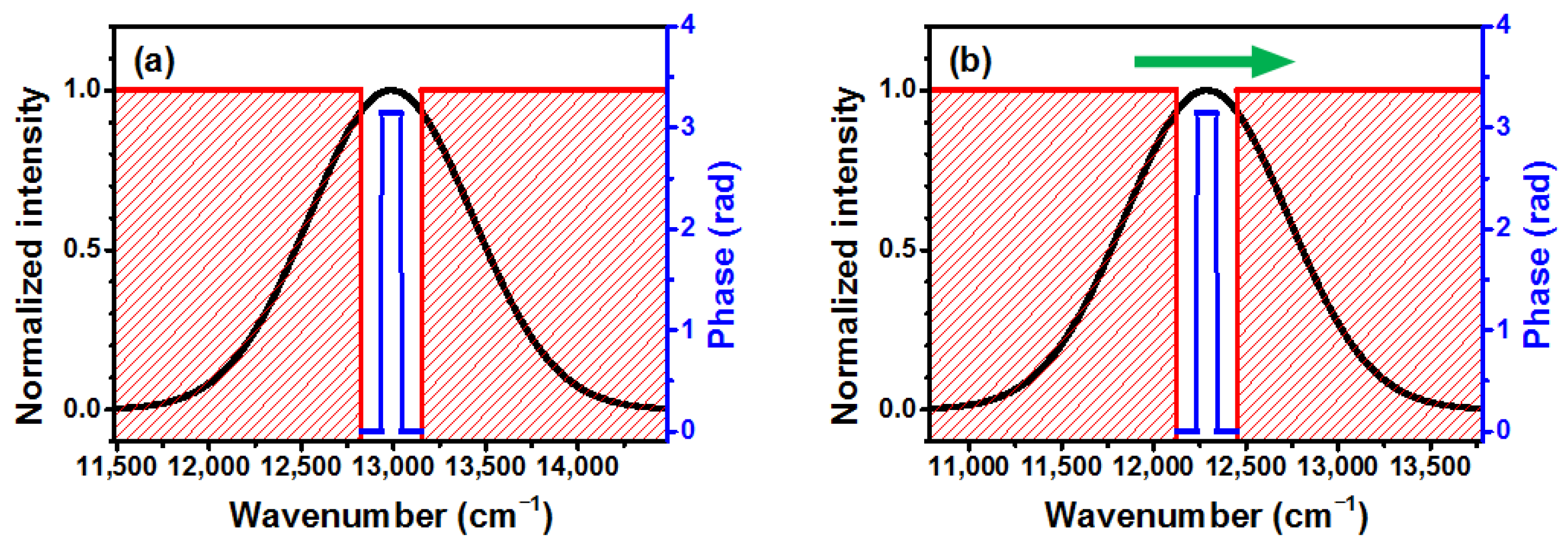




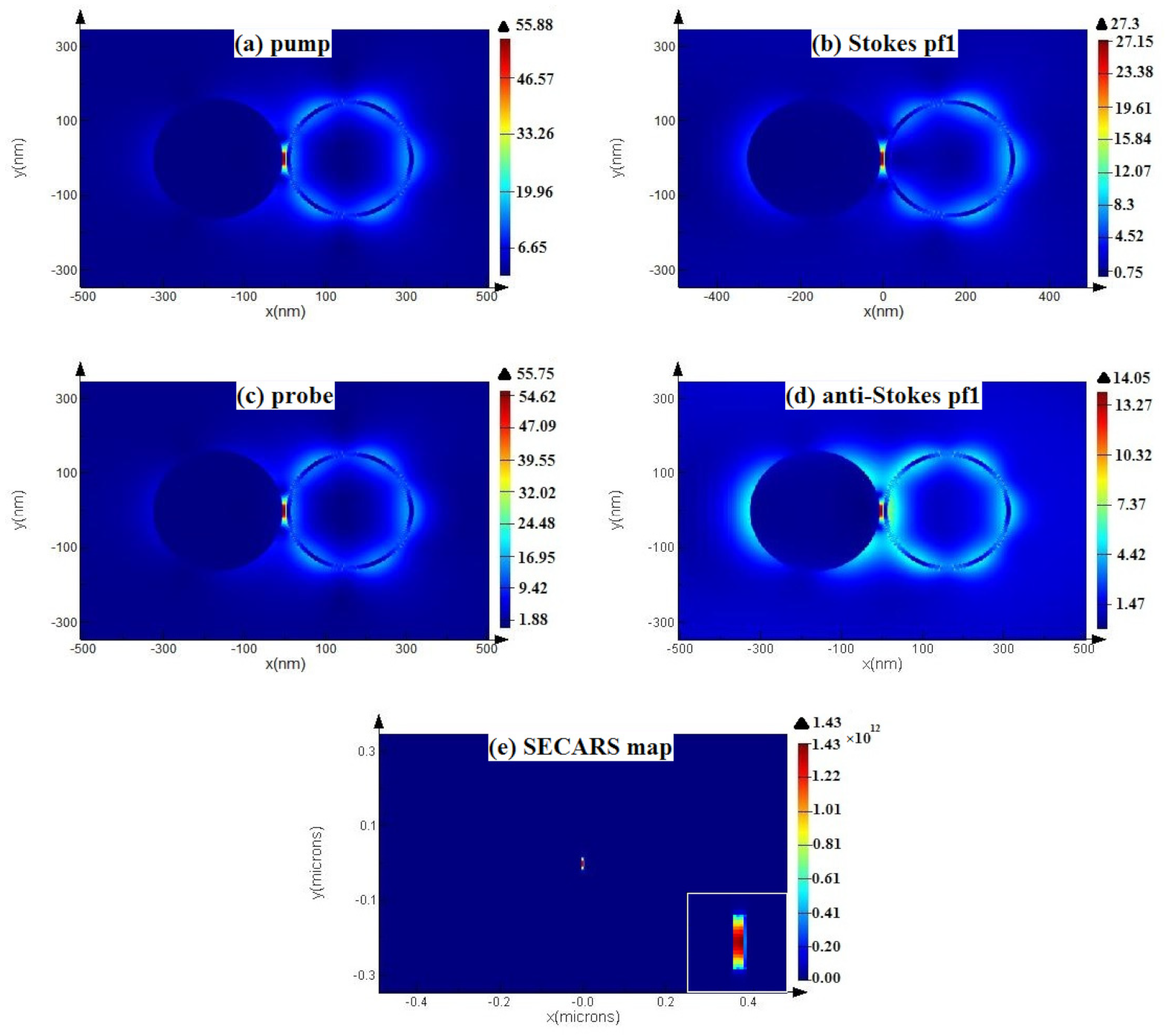
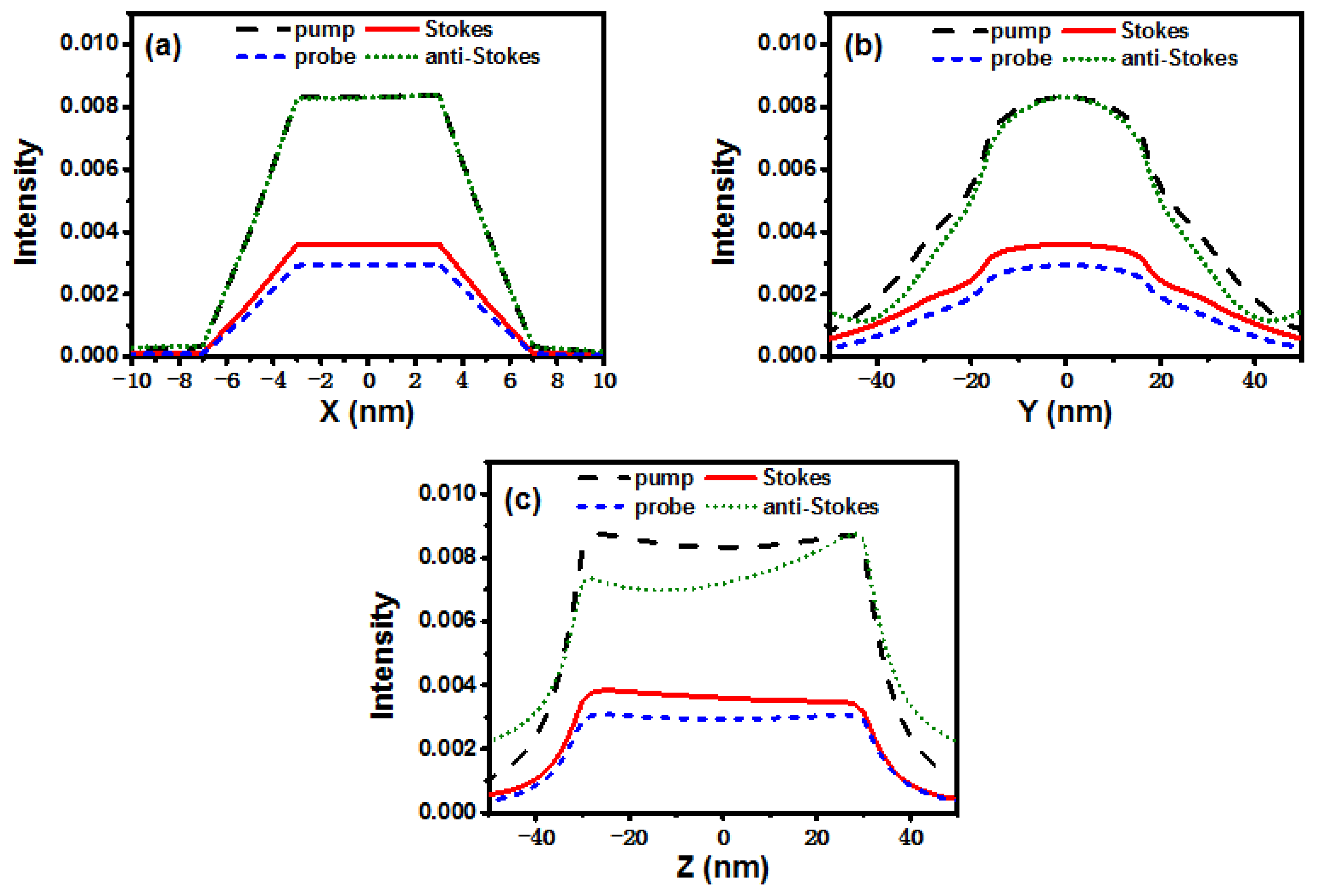


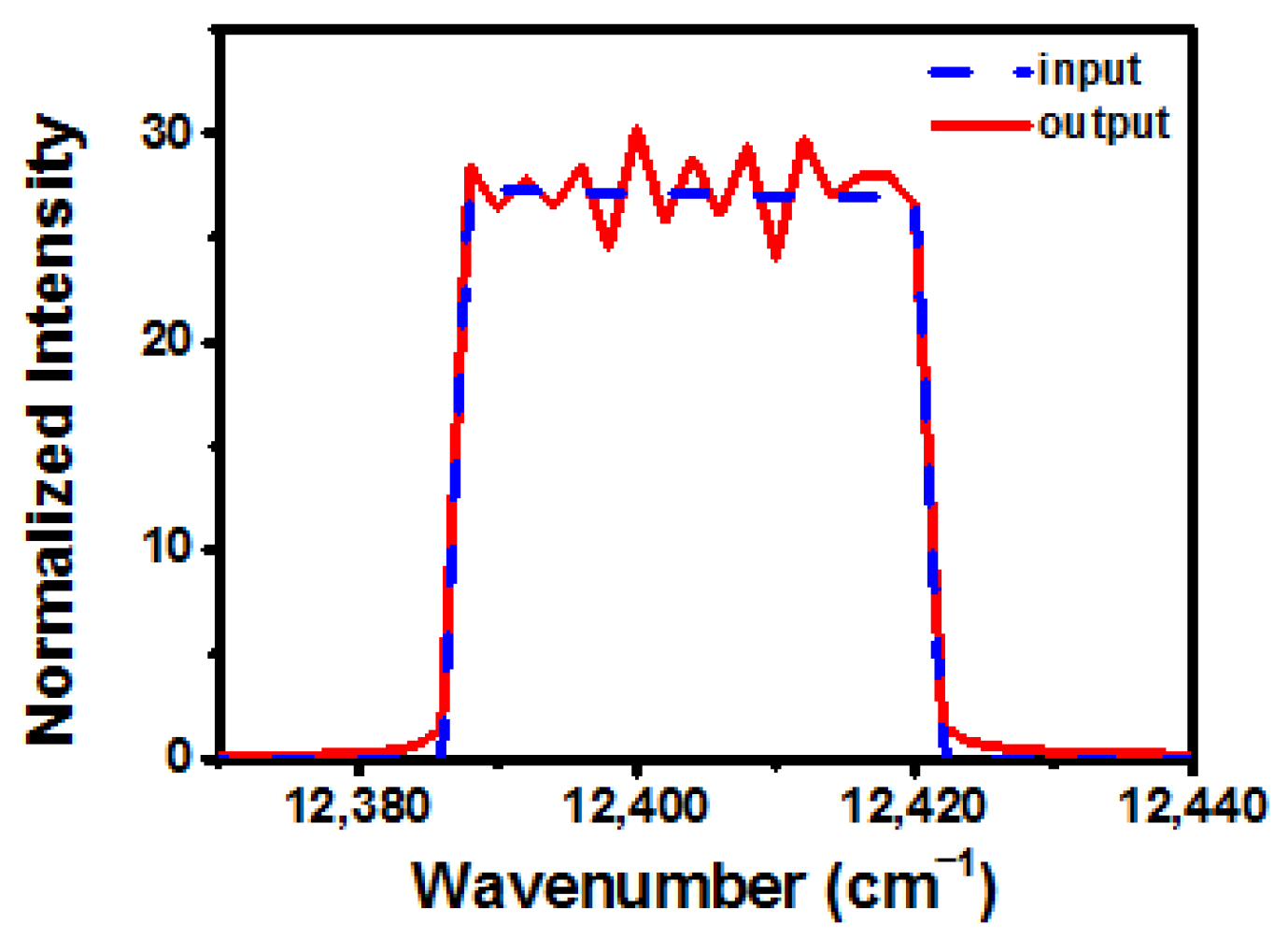
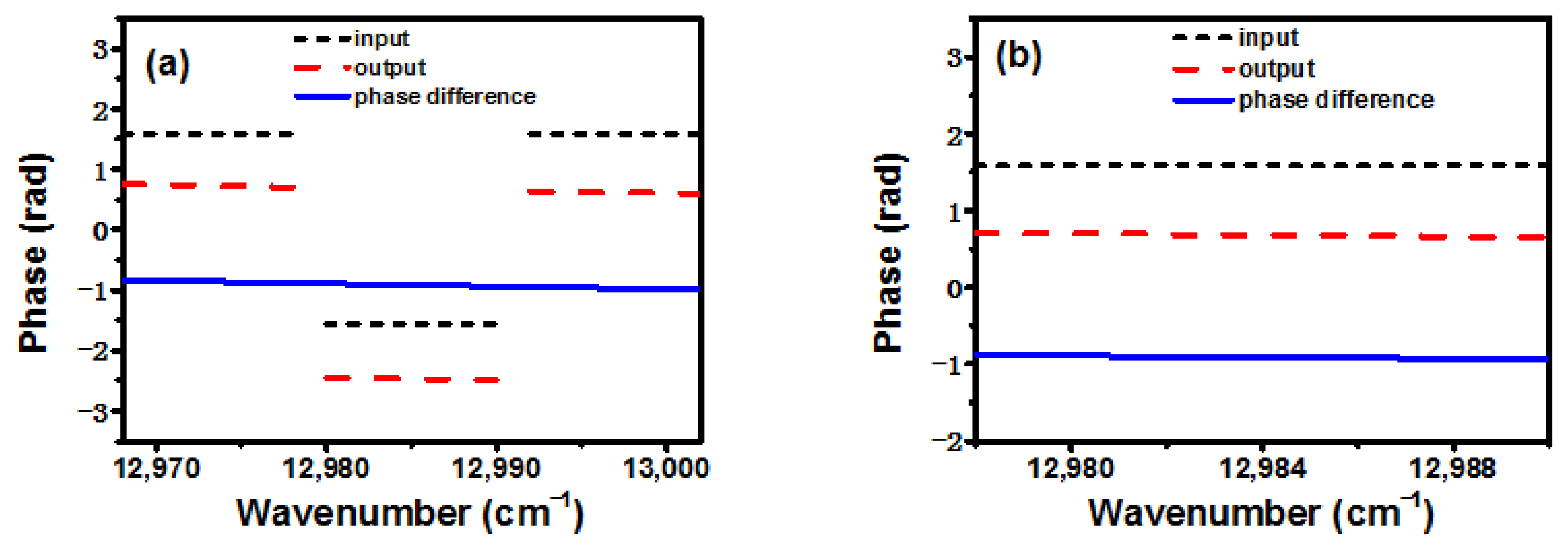
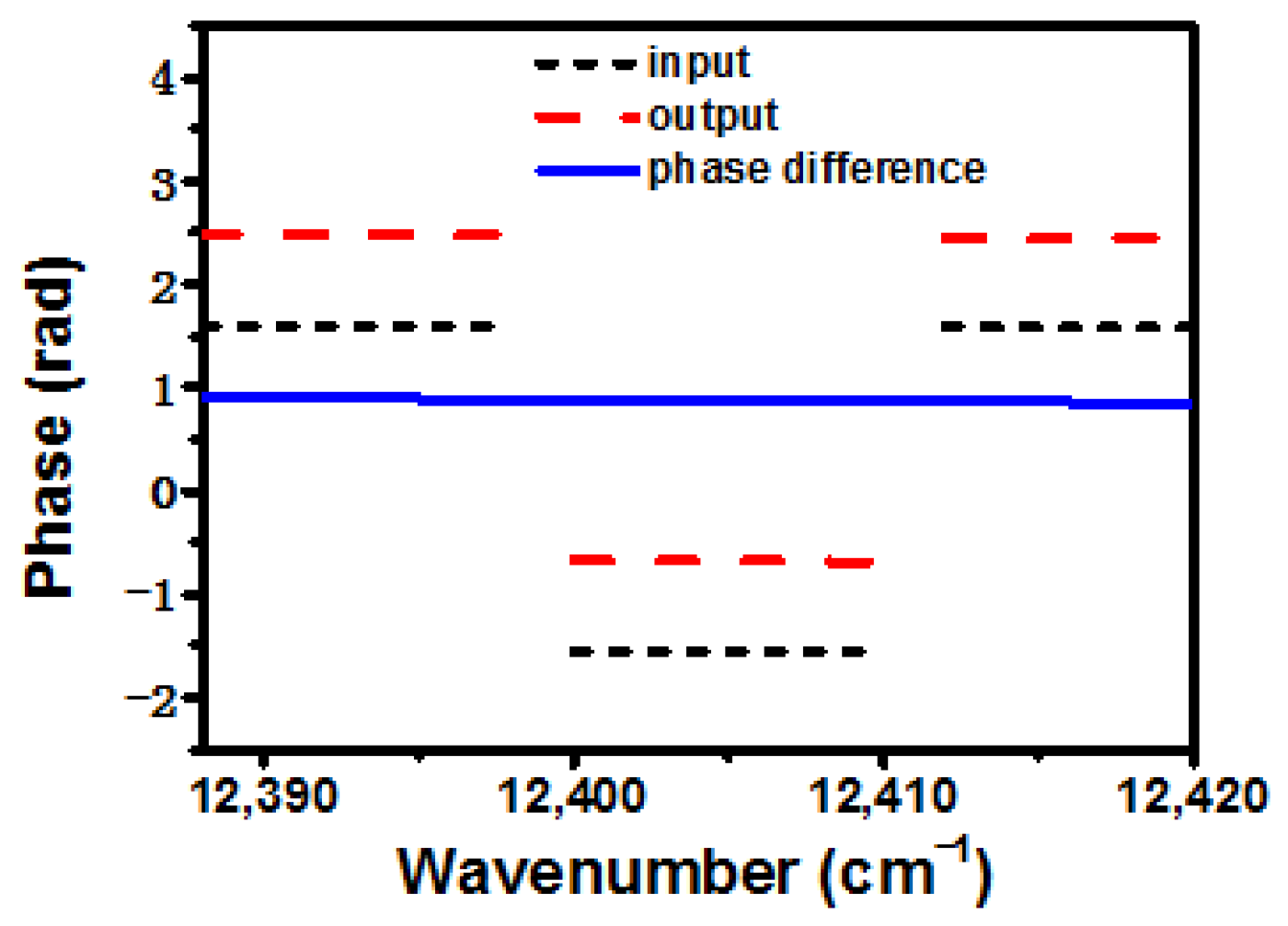
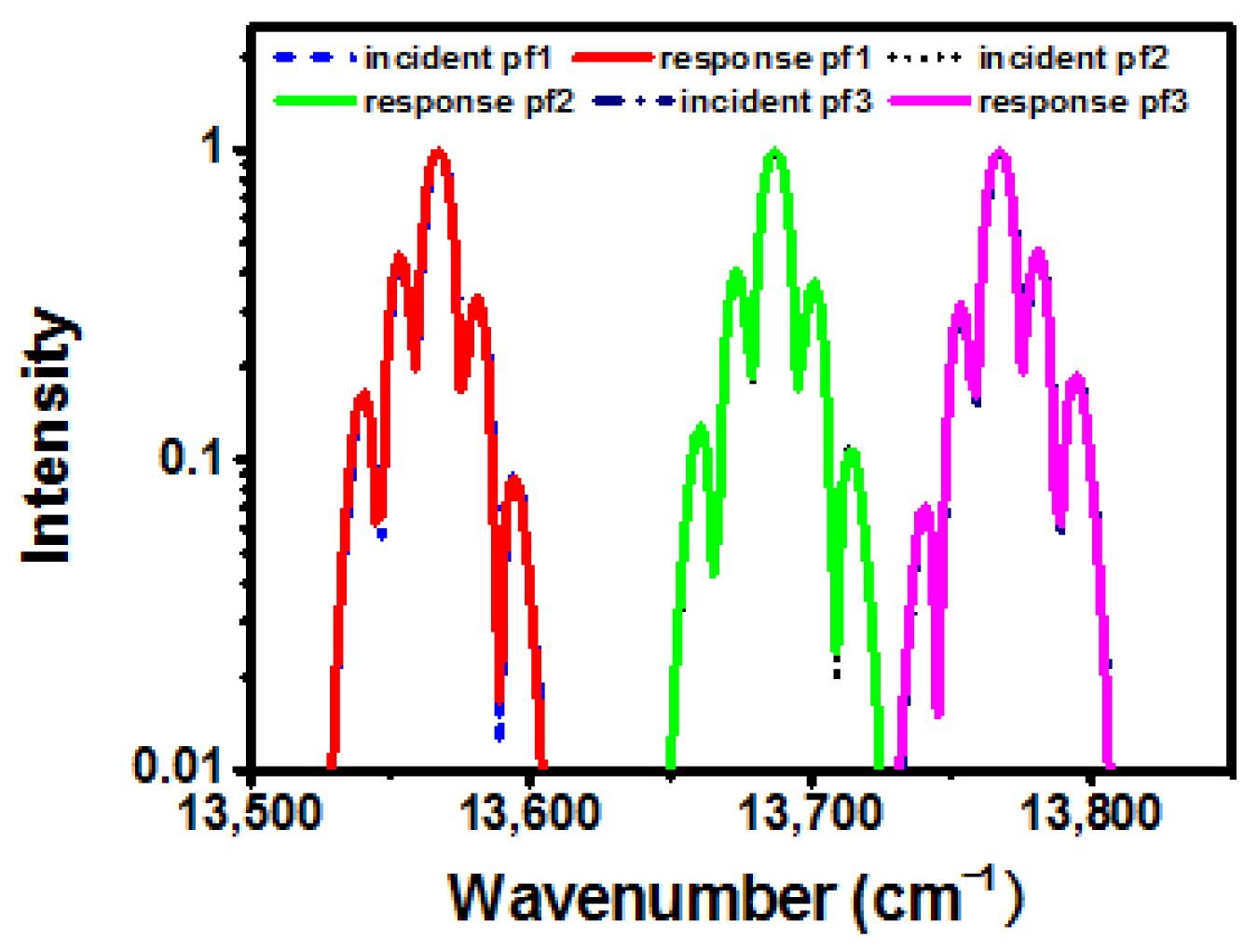
| Parameters | Settings | Parameters | Settings |
|---|---|---|---|
| R1 | 160 nm | R2 | 157 nm |
| W | 10 nm | D | 10 nm |
| Height | 60 nm | μ | 1 |
| Material | Ag | volume | 1500 × 1200 × 900 nm3 |
| Boundary condition | Perfectly matched layers |
Publisher’s Note: MDPI stays neutral with regard to jurisdictional claims in published maps and institutional affiliations. |
© 2022 by the authors. Licensee MDPI, Basel, Switzerland. This article is an open access article distributed under the terms and conditions of the Creative Commons Attribution (CC BY) license (https://creativecommons.org/licenses/by/4.0/).
Share and Cite
Xia, Y.; Cao, K.; Zhao, H.; Zhang, S.; Feng, D.; Sun, Z.; Li, J.; Jia, T. Theoretical Study on the Ultrafast Selective Excitation of Surface-Enhanced Coherent Anti-Stokes Raman Scattering Based on Fano Resonance of Disk-Ring Nanostructures by Shaped Femtosecond Laser Pulses. Photonics 2022, 9, 338. https://doi.org/10.3390/photonics9050338
Xia Y, Cao K, Zhao H, Zhang S, Feng D, Sun Z, Li J, Jia T. Theoretical Study on the Ultrafast Selective Excitation of Surface-Enhanced Coherent Anti-Stokes Raman Scattering Based on Fano Resonance of Disk-Ring Nanostructures by Shaped Femtosecond Laser Pulses. Photonics. 2022; 9(5):338. https://doi.org/10.3390/photonics9050338
Chicago/Turabian StyleXia, Yingjie, Kaiqiang Cao, Hua Zhao, Shian Zhang, Donghai Feng, Zhenrong Sun, Jinping Li, and Tianqing Jia. 2022. "Theoretical Study on the Ultrafast Selective Excitation of Surface-Enhanced Coherent Anti-Stokes Raman Scattering Based on Fano Resonance of Disk-Ring Nanostructures by Shaped Femtosecond Laser Pulses" Photonics 9, no. 5: 338. https://doi.org/10.3390/photonics9050338
APA StyleXia, Y., Cao, K., Zhao, H., Zhang, S., Feng, D., Sun, Z., Li, J., & Jia, T. (2022). Theoretical Study on the Ultrafast Selective Excitation of Surface-Enhanced Coherent Anti-Stokes Raman Scattering Based on Fano Resonance of Disk-Ring Nanostructures by Shaped Femtosecond Laser Pulses. Photonics, 9(5), 338. https://doi.org/10.3390/photonics9050338





